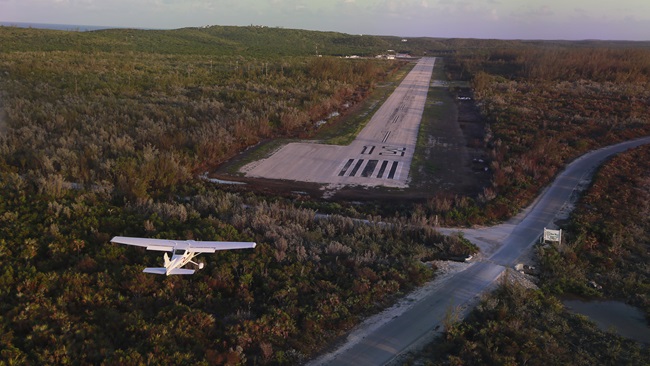My grass roots
Lessons learned from landing on turf
Modern pilots seeking to return to aviation’s roots have grown fascinated with landing airplanes on turf. It’s important to remember, however, that a grass runway may or may not satisfy the desire to land somewhere that's vastly different from home base.
As someone who learned to fly from a grass strip nigh on 65 years ago, I stand back and observe this newfound enchantment with a certain amusement. For us, there was nothing unusual about grass-field flying. I was probably in my second year of flight training before I first heard the unsettling noise of tires contacting pavement. By then, I had already learned that our airport’s turf runway needed to be approached with caution at times. There was a water-retaining low spot one-fourth of the way down from the north end, best to be avoided if it had rained within the past week. Since the runway was about 200 feet wide, which we considered spacious enough to permit simultaneous landing and taxiing operations, one could conveniently swing around the bog in the absence of conflicting traffic.
During the rest of the year, any recent rain meant a preflight inspection of our airstrip was needed. Although it was well drained, a day or two of drying out might be necessary before it became usable. Much depended on the amount of rainfall. I learned early on to keep a nose landing gear light during taxi by holding the elevators full up. Somewhere in my archives, I have a picture of a Cessna 182's nosewheel buried in the mud, down to the top of its plastic fairing; adding power without holding the yoke back turned the muscular Skylane into a mechanical mole.
Once, in a hurried attempt to impress a certain young lady with my aeronautical prowess, I taxied down to the extreme end of the runway, turned around, and buried one wheel in a soft spot. I had to leave her in the airplane while I walked all the way back to the hangar to get some planks to use to extricate the airplane. My old tailwheel trainer would have negotiated the swampy area easily, given its upward-angled thrust line.
Runway maintenance
Our home field was kept well mowed, but we knew better than to rely on other grass runways being similarly maintained. Some private owners let their personal strips grow long for a hay cutting in early summer, or perhaps mowed only a narrow portion that was sufficient for their own use. My friend Don McEwan once landed in a private field’s tall grass and suffered a locked-up brake disc from blades and stems that wrapped around one of his wheels, swerving him into a hangar. Such untended grass could hide hazards like gopher holes, rocks, and retained water. More than six inches of growth made an airstrip marginal for use, and anything near that amount required extra takeoff distance. A couple of inches of nice grass was ideal. Someone told us that pavement would reduce departure ground roll by 10 percent or so, but we didn’t measure our efforts that closely.
Landing on grass provided a “brushing” effect that kept the rollout short, so our half-mile of turf was more than adequate, even for light twins. Because of the good acceleration of these higher-horsepower airplanes, takeoff ground roll wasn’t severely lengthened. Our only concern during landing was encountering wet, dew-soaked grass that lubricated braked tires, greatly reducing traction. Only after slowing well below touchdown speed would the brakes become effective.
More than once, I heard of a pilot intending to land at some poorly defined private strip and setting his airplane down in a spot other than the runway. Orientation at an unfamiliar field can be difficult because grass airstrips look like, well, grass. Frequent use marks the centerline as a bare, beaten-down pathway, but if the strip hasn’t been used for a while, or if it was mowed recently, it will resemble the pasture next door. One side of a hayfield looks pretty much like another. In the absence of a hangar and windsock, you might easily mistake a field road for the runway. If you’re not really sure of the runway’s exact orientation, don’t land.
Judging suitability
As students, we were taught how to “drag the strip” when landing at an unknown field. The high recon pass was to be flown at traffic pattern height of 800 feet agl, checking for the waving motion of tall grass, any edge markers or signs of use that defined the runway, and obstructions in the approach and departure paths. Then we would fly a lower precautionary approach down to 100 to 200 feet, proceed alongside the runway with adequate power to avoid a stall, and look for smaller threats to confirm it was usable. Full power was then applied to ascend to a normal traffic pattern height for landing. Even then, one kept an eye out for last-second menaces requiring a go-around.
Nowadays, such low-level reconnaissance, if there are people, vehicles, or dwellings nearby, could be deemed a violation of FAR 91.119, the minimum safe altitude rule, and making a low pass could lead to enforcement action. Cellphone video evidence is prevalent everywhere these days. Be that as it may, I would rather take my chances with an overzealous inspector than wreck an airplane on a rock-strewn runway.
Always bear in mind that an open-circle chart symbol only means that a runway once existed there, unpaved or with pavement less than 1,500 feet in length. It could be graded and rolled to smooth perfection, or simply designated on paper, left as nature created it. The surface could be grass, gravel, sand, or just plain old dirt. There’s no guarantee that it’s suitable for your airplane, has been maintained recently, or wasn’t washed out in the last monsoon. When it comes to grass runways, I was taught to fly with a skeptical eye; it behooves you to do likewise.



